Hostas (Hosta spp.) are shade-loving plants, prized for their large green leaves and low maintenance. They make a wonderful addition to any garden, filling in shade spots that are not adequate for sun-loving plants. It is best to plant a hosta in your garden in the early spring to allow the roots to settle in before the heat of the summer. Most of the plant’s maintenance can be performed in the early fall, before the garden ground begins to freeze.
Here on the Green Pinky, we have a few fall care tips that will help your hostas grow and thrive. The leaves can sometimes become disease or pest-ridden, just like any other garden plant. Gardeners can employ the tricks below to prevent these nuisances from occurring.
Some of the fall care will also help prepare your hostas for winter, and the techniques can be adapted for other plants in your garden. Keep reading below for our 7 fall care tips to keep your leaves and foliage healthy.
If you like hostas, then you’ll also likely the flowers that the tropical plumeria tree can bring to a space. Check out how to raise plumerias so that they can create beautiful blooms.

7 Hostas Fall Care Tips
1. Divide Them
Dividing hostas is not usually required for their health. When they are grown close to one another, they will naturally grow slower with no ill effects. However, dividing can help create a neater appearance and can be used to create two plants out of one.
You can separate a hosta clump in two with the help of a sharp spade. Cut the crown of the plant, leaving at least one “eye” on each piece. Otherwise, you can pull the entire clump and slice off a section that you want. Be sure to keep as much of the roots intact as possible, as this will ensure the new plant’s survival. Plant them at the same soil level that it came from and water it in. Continue to water the new planting site well until the plant is fully established.
It is best to divide them in early fall before the first frost. You want to allow them to take root before the first frost of fall sends the plants into dormancy.
2. Cut Them Back
You can cut back your leaves to help prepare it for winter. Hostas tend to naturally die back and wither away, with the plant almost seeming to die. However, this is part of their life cycle and they will come back stronger than ever in the spring, bursting with new leaves. While you can leave the plant to perform this dormancy preparation on its own, the plant will benefit from your assistance.
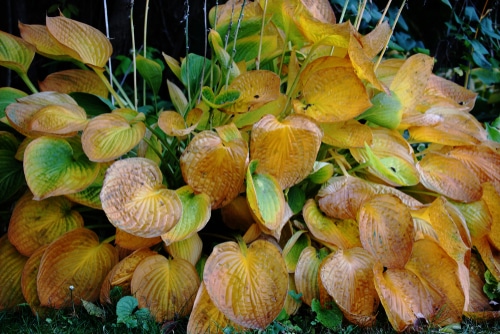
Using pruning shears, cut back and trim any dead or pest-eaten leaves. This will discourage slugs and other pests from dining on the weak, dying leaves and leave the plant more sightly and uniform. Feel free to cut back as many leaves as you wish. The more leaves that are left to die and wither, the higher the chance that diseases and pests will move in.
Some gardeners even choose to cut off all of the foliage, leaving just little stems protruding from the ground. Although this can be a scary thing to do, your hostas will thank you for it. They should be disease and pest free, ready to grow new foliage in the early spring.
3. Mulch
Mulching is recommended in most climates. Adding a 3-inch layer of mulch in the fall season will help preserve water through the end of the growing season, allowing you to water the plants less often. The mulch also provides a thermal blanket for the plants’ roots, regulating the temperature as the ground starts to freeze.
Pine needles work great as a mulch, but any mulch you have on hand should suffice. If you are in hardiness zones 5 or below, mulch will be less critical. In these areas, the ground freezes nearly all winter, so mulch will not provide the same thermal benefits.
For hostas planted in pots, you can bury the pot, with the top of the pot at ground level. Then, apply mulch around the plant to help it withstand the cold temperatures. Otherwise, you can provide them with winter shelter in your home or garage.
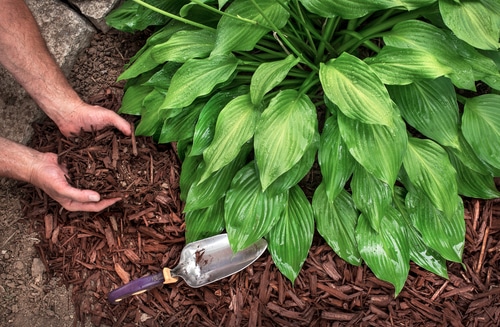
4. Get Rid of Slugs
Slugs (and the holes they leave) are a common sight on hostas. Slugs are most active when the temperatures are warm and the soil moisture is high. If you experience some heavy rain, you may want to take preventive action to discourage slugs from eating your hostas.
One classic method to get rid of slugs involves using beer. Place a shallow bowl or pan near your plant and fill it with the cheapest beer you have, ensuring that the top of the bowl is at ground level and even with the soil line. The slugs are attracted to the yeasty, fermented smell and end up drowning in the liquid. Check your trap daily, discarding the slugs and replacing the beer.
Removing debris from the ground around your plants will remove possible slug habitats and any eggs that they have already laid. Similarly, thinning the hostas in the area of the infestation will provide more air flow and less-ideal conditions for slugs.
5. Prevent Disease
If you have been providing proper care, including proper watering, mulching, and other care, then your hosta plants should be disease-free. However, if preventative care did not work, you can use a few tricks to eliminate diseases.
If your plants are contracting fungal diseases like crown rot, thinning or dividing them may help solve the problem. Fungi prefer moist environments, so thinning your plants will provide more fresh air and less chances for fungal spore germination. Be careful not to overwater the soil.
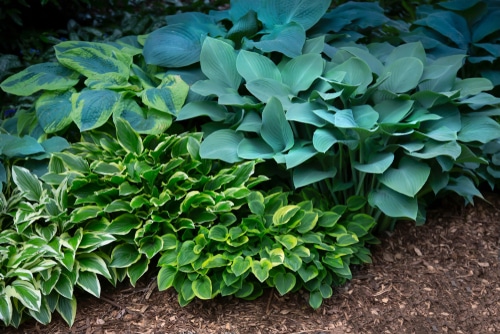
If you want another interesting article to read, check out how to create espalier fruit trees for some truly design-forward trees!
6. Do Not Fertilize
There is no need to fertilize after the middle of summer. If you add fertilizer too close to the fall, your plants may have trouble preparing for winter and dormancy. Fertilizer promotes new leaves to grow, and these fresh leaves can increase the plant’s susceptibility to frost damage. The frost damage from these weak leaves would affect the entire plant, including the crown and roots.
An application of fertilizer is best when it is provided in early spring. This gives the plants the fuel they need to create new foliage throughout the year. A second round can be applied in mid-summer, but do not apply fertilizer after the temperatures start to drop in your area. This will confuse the roots.
7. Trim Flowers – Or Not
Hostas are known for the beauty of their green foliage, but they also produce beautiful flower stalks. Depending on your goals, you may choose to trim these flower stalks off of the plants and forego the blooms. The leaves definitely deserve to be the star of the show.
Most species bloom and flower for a few weeks between early summer and early fall, depending on the location. If you want to enjoy the blooms, then just let them grow. If you want your plants to focus more on growing leaves, then cut the flowers off as they appear. If you are thinking about dividing your hostas in the fall, you will probably want to cut flowers off to allow for full growth of your plant.
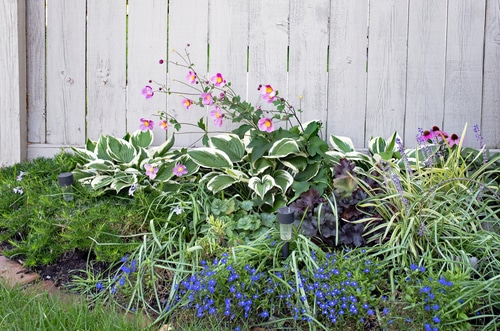
Low Maintenance and Beautiful Foliage
Now it’s time to get out there and take care of your hostas! It will provide you with plenty of attractive foliage throughout the fall season as long as you give it the care it deserves. Most of this care should be performed in early fall, before the first frost triggers their leaves to die back.
While planted hostas are relatively hardy and maintenance-free, they still appreciate the touch of competent gardeners. As the ground and soil begin to freeze, most plant species in your garden will benefit from mulching. The roots will do better throughout the fall when the soil can retain as much warmth as possible.
Garden areas can easily become infested with pests or disease if they are allowed to exist, so be sure to eliminate those garden pests as soon as possible. Slugs love to munch on plant leaves, so always be on the lookout for holes in your leaves. The soil moisture of the ground can also harbor fungal diseases, so keep the plant leaves fresh and aerated by trimming and cleaning around your gardens this fall.
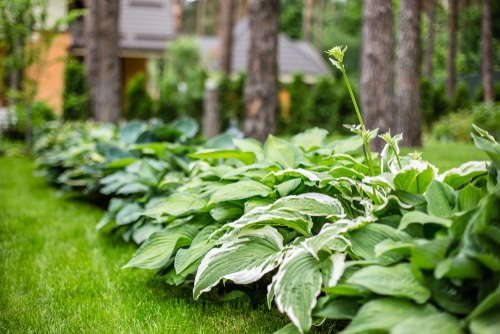
Your hostas will thank you for performing this fall maintenance on them. You will notice the difference next spring when you have a thriving hosta garden!

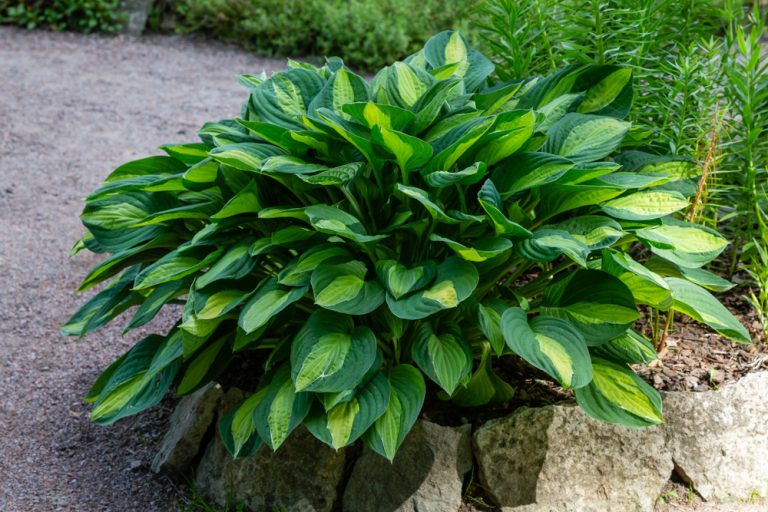
How do you prevent deer from eating my hostas,they ruined mine this year.